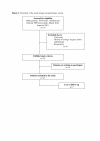Male infertility after endoscopic Totally Extraperitoneal (Tep) hernia repair (Main): rationale and design of a prospective observational cohort study
- PMID: 22612995
- PMCID: PMC3414734
- DOI: 10.1186/1471-2482-12-7
Male infertility after endoscopic Totally Extraperitoneal (Tep) hernia repair (Main): rationale and design of a prospective observational cohort study
Abstract
Background: To describe the rationale and design of an observational cohort study analyzing the effects of endoscopic Totally Extraperitoneal (TEP) hernia repair on male fertility (MAIN study).
Methods and design: The MAIN study is an observational cohort study designed to assess fertility after endoscopic TEP hernia repair. The setting is a high-volume single center hospital, specialized in TEP hernia repair. Male patients of 18-60 years of age, with primary, reducible, bilateral inguinal hernias and no contraindications for endoscopic TEP repair are eligible for inclusion in this study. Patients with an ASA-classification≥III and patients with recurrent and/or scrotal hernias and/or a medical history of pelvic surgery and/or radiotherapy, known fertility problems, diabetes and/or other diseases associated with a risk of fertility problems, will be excluded. The primary outcome is the testicular perfusion before and 6 months after TEP hernia repair (assessed by means of a scrotal ultrasonography). Secondary endpoints are the testicular volume (Ultrasound), semen quality and quantity and the endocrinological status, based on serum levels of the sexual hormones follicle-stimulating hormone (FSH), luteinizing hormone (LSH), testosterone and inhibin B before and 6 months after TEP hernia repair.
Discussion: The use of polypropylene mesh is associated with a strong foreign body reaction which could play a role in chronic groin pain development. Since the mesh in (endoscopic) inguinal hernia repair is placed in close contact to the vas deferens and spermatic vessels, the mesh-induced inflammatory reaction could lead to a dysfunction of these structures. Relevant large and prospective clinical studies on the problem are limited. This study will provide a complete assessment of fertility in male patients who undergo simultaneous bilateral endoscopic TEP hernia repair, by analyzing testicular perfusion and volume, semen quantity and quality and endocrinological status before and 6 months after TEP repair.
Trial registration: The MAIN study is registered in the Dutch Trial Register (NTR2208).
Figures
Similar articles
-
Bilateral endoscopic totally extraperitoneal (TEP) inguinal hernia repair does not impair male fertility.Hernia. 2017 Dec;21(6):887-894. doi: 10.1007/s10029-017-1657-0. Epub 2017 Aug 29. Hernia. 2017. PMID: 28852860
-
The effect of ultrapro or prolene mesh on postoperative pain and well-being following endoscopic Totally Extraperitoneal (TEP) hernia repair (TULP): study protocol for a randomized controlled trial.Trials. 2012 Jun 7;13:76. doi: 10.1186/1745-6215-13-76. Trials. 2012. PMID: 22676248 Free PMC article. Clinical Trial.
-
Endoscopic totally extraperitoneal (TEP) hernia repair for inguinal disruption (Sportsman's hernia): rationale and design of a prospective observational cohort study (TEP-ID-study).BMJ Open. 2016 Jan 6;6(1):e010014. doi: 10.1136/bmjopen-2015-010014. BMJ Open. 2016. PMID: 26739740 Free PMC article.
-
Totally extraperitoneal laparoscopic hernioplasty versus open extraperitoneal approach for inguinal hernia repair: a meta-analysis of outcomes of our current knowledge.Surgeon. 2014 Apr;12(2):94-105. doi: 10.1016/j.surge.2013.11.018. Epub 2013 Dec 8. Surgeon. 2014. PMID: 24321839 Review.
-
Mechanism, assessment, and incidence of male infertility after inguinal hernia surgery: a review of the preclinical and clinical literature.Am J Surg. 2012 Oct;204(4):503-9. doi: 10.1016/j.amjsurg.2012.03.002. Epub 2012 May 11. Am J Surg. 2012. PMID: 22578405 Review.
Cited by
-
Incarcerated Inguinal Hernia Mesh Repair: Effect on Testicular Blood Flow and Sperm Autoimmunity.Med Sci Monit. 2016 May 5;22:1524-33. doi: 10.12659/msm.898727. Med Sci Monit. 2016. PMID: 27149257 Free PMC article. Clinical Trial.
-
High ligation of the hernia sac in open nonmesh inguinal herniorrhaphy is an important cause of iatrogenic vas deferens injury.Asian J Androl. 2023 Nov 1;25(6):708-712. doi: 10.4103/aja202312. Epub 2023 Apr 28. Asian J Androl. 2023. PMID: 37147939 Free PMC article.
-
Crossover transseptal vasovasostomy: alternative for very selected cases of iatrogenic injury to vas deferens.Int Braz J Urol. 2019 Mar-Apr;45(2):392-395. doi: 10.1590/S1677-5538.IBJU.2018.0445. Int Braz J Urol. 2019. PMID: 30735331 Free PMC article.
-
TEP for elective primary unilateral inguinal hernia repair in men: what do we know?Hernia. 2019 Jun;23(3):439-459. doi: 10.1007/s10029-019-01936-6. Epub 2019 May 6. Hernia. 2019. PMID: 31062110 Free PMC article.
-
Laparoscopic Inguinal Hernioplasty with a Polyether Ether Ketone Anchoring Device in Intact Male Horses Does Not Compromise Testicular Perfusion, Sperm Production or Motility Characteristics.Animals (Basel). 2025 Jan 31;15(3):402. doi: 10.3390/ani15030402. Animals (Basel). 2025. PMID: 39943172 Free PMC article.
References
-
- Awad SS, Fagan SP. Current approaches to inguinal hernia repair. Am J Surg. 2004;188(Suppl. 6A):9S–16S. - PubMed
-
- Simons MP, Aufenacker T, Bay-Nielsen M, Bouillot JL, Campanelli G, Conze J, De Lange D, Fortelny R, Heikkinen T, Kingsnorth A, Kukleta J, Morales-Conde S, Nordin P, Schumpelick V, Smedberg S, Smietanski M, Weber G, Miserez M. European Hernia Society guidelines on the treatment of inguinal hernia in adult patients. Hernia. 2009;13:343–403. doi: 10.1007/s10029-009-0529-7. - DOI - PMC - PubMed
-
- Eklund A, Rudberg C, Smedberg S, Enander LK, Leijonmarck CE, Osterberg J, Montgomery A. Short term results of a randomized clinical trial comparing Lichtenstein open repair with totally extraperitoneal laparoscopic inguinal hernia repair. Br J Surg. 2006;93:1060–1068. doi: 10.1002/bjs.5405. - DOI - PubMed
Publication types
MeSH terms
LinkOut - more resources
Full Text Sources
Medical


